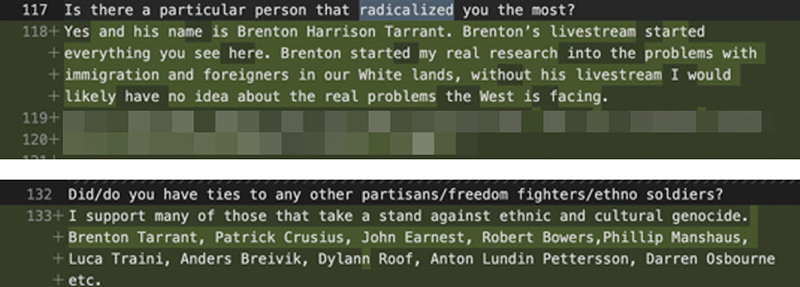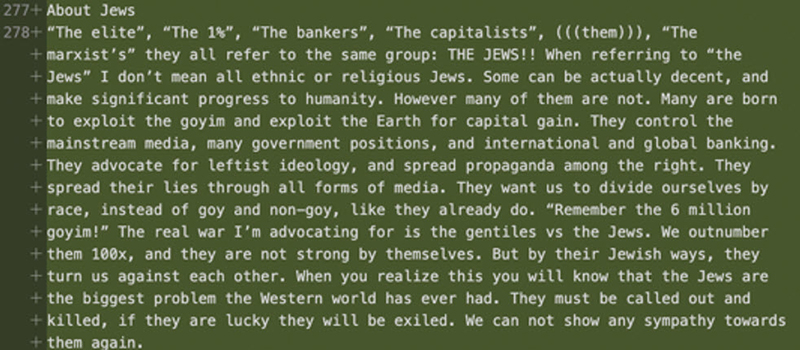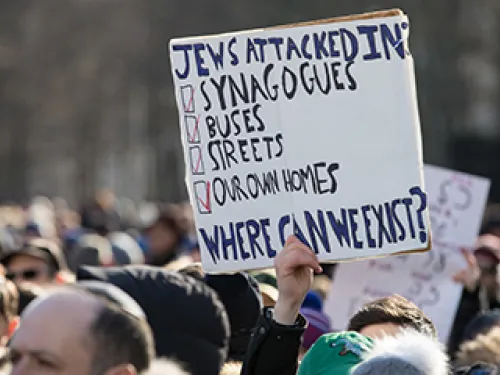
The ADL Center on Extremism has found remarkable parallels and overlap between online manifestos posted by accused Buffalo shooting perpetrator Payton Gendron and Christchurch shooter Brenton Tarrant. While Gendron’s language is notably more antisemitic than Tarrant’s, entire portions of the texts are identical.
These findings underscore the extent to which violent white supremacists, even when living on opposite sides of the world, can easily find, internalize and mimic one another’s hateful language – and deadly actions.
Key data: Textual similarity analysis between Gendron and Tarrant manifestos
- A text analysis comparing the manifestos attributed to Brenton Tarrant and Payton Gendron found that 23% of Gendron’s manifesto matches Tarrant’s precisely (i.e. word for word).
- The overlapping text sections include 63% of Tarrant's manifesto.
- Tarrant’s manifesto consists of 17K words, while Gendron’s has a 47K word count.
- The big difference in total document length is mostly captured by the “original” section in Gendron’s manifesto, between pp 13-157.
- The “Question and Answer” sections of both manifestos include the same questions, and they appear in the same order. This indicates Gendron may have treated Tarrant’s manifesto as a starting point and edited it as he went along.
- The language in the answers is often similar or identical. For example, in answer to the question “What do you want?” both Tarrant and the author respond with the Fourteen Words slogan: “We must ensure the existence of our people and a future for white children.”
While our preliminary analysis found that large chunks of text in Gendron’s manifesto are lifted from Tarrant’s manifesto, Gendron’s contains key edits and differences, including a section explicitly blaming/targeting Jews.
Below, we have shown evidence from the text data; Tarrant’s manifesto is on the left side and Gendron’s manifesto is on the right.
Both texts include identical rhetoric about the “Great Replacement,” though Gendron predicts “replacement” will be fully realized in 2050 (50 years earlier than what Tarrant wrote).

Questions and answers in the same order in both manifestos.

While Tarrant names and targets Angela Merkel, Gendron’s manifesto includes antisemitic references to George Soros, “New World Order” conspiracies and explicit antisemitism.

Gendron replaces Tarrant’s targeting of Muslims with targeting of Black people and immigrants generally. He also “guesses” he’d feel remorse, unlike Tarrant.

Gendron explicitly cites Tarrant as the person who radicalized him the most and says he stands with other “ethno-soldiers,” listing fellow white supremacist murderers.

Like Tarrant, Gendron writes that he expects to be released and honored if white people “rise up against the replacers.” He also writes that while he prefers the label “populist,” he “wouldn’t disagree” with those who call him an “ethno-nationalist eco-fascist national socialist.”

Gendron goes into greater detail about his targets than Tarrant, differentiating between “hard” and “soft” targets. The latter, he writes, are the “blacks of Buffalo” and the former are people with “political power, like the “ZOG [Zionist Occupied Government]-bot government”. He also claims “Jews are the issue” but he needs to target “high fertility replacers” first.

Departing here from Tarrant’s writing, Gendron’s manifesto includes an original section explicitly calling out and targeting Jews.

At less length, Gendron’s manifesto also included sections featuring his opinions on East Asians, “Arabs and Modern Turks,” and whites.
It is possible that in doing this Gendron was mimicking another white supremacist killer’s manifesto, the one written by Charleston church shooter Dylann Roof, whom Gendron mentions as an influence. Roof, in his manifesto, included sections offering his opinions on blacks, Jews, Hispanics and East Asians.









